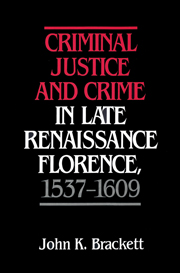Book contents
- Frontmatter
- Contents
- Acknowledgments
- Introduction
- 1 The bureaucratic structure of the Otto: the personnel and their functions
- 2 Financing the Otto
- 3 The Otto as police: organization and function
- 4 Criminal procedure before the Otto: from discovery to sentencing
- 5 The Otto and its role in the centralization of criminal justice in the Florentine state
- 6 Crime and criminals
- Conclusion
- Appendix 1 Names of other officers of the Otto di Guardia e Balìa, 1537–1609, as we have them
- Appendix 2 Budget totals by year
- Appendix 3 Comparison of detailed average expenditures for budgets, 1537–1547 and 1598–1609
- Appendix 4 Occupation key
- Bibliography
- Index
3 - The Otto as police: organization and function
Published online by Cambridge University Press: 05 September 2009
- Frontmatter
- Contents
- Acknowledgments
- Introduction
- 1 The bureaucratic structure of the Otto: the personnel and their functions
- 2 Financing the Otto
- 3 The Otto as police: organization and function
- 4 Criminal procedure before the Otto: from discovery to sentencing
- 5 The Otto and its role in the centralization of criminal justice in the Florentine state
- 6 Crime and criminals
- Conclusion
- Appendix 1 Names of other officers of the Otto di Guardia e Balìa, 1537–1609, as we have them
- Appendix 2 Budget totals by year
- Appendix 3 Comparison of detailed average expenditures for budgets, 1537–1547 and 1598–1609
- Appendix 4 Occupation key
- Bibliography
- Index
Summary
Giovanni Antonelli, the Italian historian whose long article on the development of the Otto di Guardia appeared in 1954, drew attention to the magistracy's role in the fourteenth and fifteenth centuries as political police empowered to seek out and punish those who plotted against the regime. The office served Lorenzo de' Medici well during his ferocious repression of the Pazzi conspiracy of 1478, when he was wounded and his beloved brother Giuliano killed under the famous dome of the cathedral of Santa Maria del Fiore. In 1498 the Otto condemned to death Fra Giovanni Savonarola, an action engineered by the conservative faction of the oligarchy that brought an end to a particularly tumultuous period in the city's history. The Eight continued to successfully fulfill the role of political police in the sixteenth century, identifying and punishing the enemies of the recently ennobled Medici family. The report of the Venetian ambassador to Florence in 1561, Vincenzo Fedeli, underlined the importance to Cosimo I of the Eight's routine surveillance over the activities of Florentine aristocrats: First thing in the morning, the secretary delivered his daily reports in person to Cosimo. The Medici grand duke was no doubt reacting with this sense of urgency to the Pucci conspiracy of the previous year. Condemnations and executions of the conspirators and their supporters by the Eight concluded this last attempt by aristocrats to topple the Medici regime.
- Type
- Chapter
- Information
- Publisher: Cambridge University PressPrint publication year: 1992



